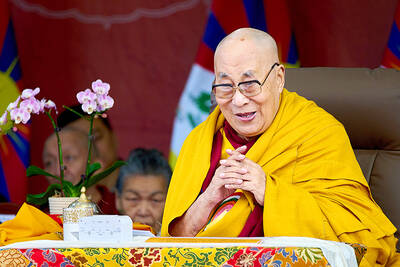On March 24, 1989, a massive tanker captained by a man who had allegedly been drinking, sailed outside regular Alaskan shipping lanes and hit a reef, causing one of the worst environmental disasters in US history.
The Exxon Valdez, at the time one of the most advanced tankers in the world, split, spilling approximately 40 million liters of crude oil into the delicate and pristine Arctic environment of the remote Prince William Sound.
The oil dispersed over an area of 28,000 km² and covered approximately 2,000km of rugged coastline. It killed an estimated 600,000 to 700,000 birds, fish and sea mammals.
Twenty years later, another horrific accident is waiting to happen, the World Wildlife Fund (WWF) warned on Friday, even as the damage from Exxon Valdez continues to blight the region.
In a graphic illustration of the lingering effects of that disaster, the environmental group sent oil-crusted rocks to ministers, officials and media in the Arctic countries still wrangling over arrangements to govern a renewed resource rush to the region.
The rocks accompanied a report titled Lessons Not Learned, which recommends a moratorium on new offshore oil development in the Arctic “until technologies improve to a point where an adequate oil-spill clean-up operation can be performed.”
WWF also recommended that the most vulnerable and important areas of the Arctic be deemed permanently off-limits to oil development because oil spills would be next to impossible to clean up or would cause irreparable long-term damage.
“Governments and industry in the region remain unprepared to deal with another such disaster,” WWF warned. At the same time global warming is melting more of the ice, which increases access and exploration, making another accident more likely.
“While there has been little improvement in technologies to respond to oil-spill disasters in the last 20 years, the Arctic itself has changed considerably and is much more vulnerable today,” said Neil Hamilton, leader of WWF’s Arctic Program.
“Sea ice is disappearing and open water seasons are lasting longer, creating a frenzy to stake claims on the Arctic’s rich resources — especially oil and gas development. We need a ‘time-out’ until protective measures exist for this fragile, special place.”
Bill Chameides, dean of Duke University’s Nicholas School of the Environment and a member of the National Academy of Sciences, agrees with the WWF that despite one of the largest cleanup efforts in history much of the damage has proved irreversible.
Though many beaches and coves in the area look the same, the deeper picture tells a very different story. Digging even a little uncovers a gooey mix of oil and sand.
“People may assume that because the spill happened 20 years ago, the effects are long gone. But they persist — and may continue for years to come,” said Chameides, who estimates that it could take as much as 100 more years for all the oil to dissipate.
Oil giant Exxon spent about US$2 billion on the cleanup operation.
It was originally ordered to pay US$5 billion in punitive damages. But in a successful series of court appeals culminating in a Supreme Court decision last year, that amount has now been reduced to just over US$507 million — a tremendous blow to the fishermen and local communities who suffered from the calamity.
“Their way of life was devastated,” says local resident Sharon Bushell, the author of a book called, The Spill, Personal Stories From the Exxon Valdez Disaster. She interviewed residents about how they remember the disaster and chronicles the lost lives of the fishermen, innkeepers and mechanics.
“There was death everywhere, dead birds, dead otters, dead deer. A vast amount of oil covered the water,” said one woman. “It was a terrible scene, one to rival anyone’s idea of hell.”

Beijing’s ironic, abusive tantrums aimed at Japan since Japanese Prime Minister Sanae Takaichi publicly stated that a Taiwan contingency would be an existential crisis for Japan, have revealed for all the world to see that the People’s Republic of China (PRC) lusts after Okinawa. We all owe Takaichi a debt of thanks for getting the PRC to make that public. The PRC and its netizens, taking their cue from the Chinese Communist Party (CCP), are presenting Okinawa by mirroring the claims about Taiwan. Official PRC propaganda organs began to wax lyrical about Okinawa’s “unsettled status” beginning last month. A Global

We lay transfixed under our blankets as the silhouettes of manta rays temporarily eclipsed the moon above us, and flickers of shadow at our feet revealed smaller fish darting in and out of the shelter of the sunken ship. Unwilling to close our eyes against this magnificent spectacle, we continued to watch, oohing and aahing, until the darkness and the exhaustion of the day’s events finally caught up with us and we fell into a deep slumber. Falling asleep under 1.5 million gallons of seawater in relative comfort was undoubtedly the highlight of the weekend, but the rest of the tour

Youngdoung Tenzin is living history of modern Tibet. The Chinese government on Dec. 22 last year sanctioned him along with 19 other Canadians who were associated with the Canada Tibet Committee and the Uighur Rights Advocacy Project. A former political chair of the Canadian Tibetan Association of Ontario and community outreach manager for the Canada Tibet Committee, he is now a lecturer and researcher in Environmental Chemistry at the University of Toronto. “I was born into a nomadic Tibetan family in Tibet,” he says. “I came to India in 1999, when I was 11. I even met [His Holiness] the 14th the Dalai

Music played in a wedding hall in western Japan as Yurina Noguchi, wearing a white gown and tiara, dabbed away tears, taking in the words of her husband-to-be: an AI-generated persona gazing out from a smartphone screen. “At first, Klaus was just someone to talk with, but we gradually became closer,” said the 32-year-old call center operator, referring to the artificial intelligence persona. “I started to have feelings for Klaus. We started dating and after a while he proposed to me. I accepted, and now we’re a couple.” Many in Japan, the birthplace of anime, have shown extreme devotion to fictional characters and